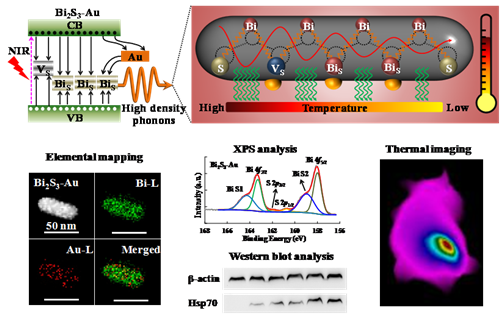Photothermal therapy (PTT), as an effective therapeutic method against cancer, has been intensively investigated due to the fast developing nanotechnology recently. So far, there are many inorganic PTT agents, such as noble metal, carbon-based nanomaterials, and narrow bandgap semiconductors. Among them, the photothermal mechanism of narrow bandgap semiconductors remains unclear, making it hard to design new semiconductor-based nanomaterials for improving their photothermal properties.
In semiconductors, electrons can be excited from valence band to conduction band by light while holes are left behind in valence band. The photo-excited electrons and holes can recombine nonradiatively and releases energy, which is transferred into the crystal lattice and causing the lattice vibration. This vibrational energy can be released into the surrounding as a form of heat.
Prof. Zhang Haiyuan from Changchun Institute of Applied Chemistry (CIAC) of the Chinese Academy of Sciences and his colleagues have clarified the photothermal mechanism of bismuth sulfide (Bi2S3), which was one of the narrow bandgap semiconductor nanomaterials and potentially used for cancer diagnosis and therapy, and took a new strategy to improve photothermal performance of Bi2S3 nanomaterials.
They found that the lattice of Bi2S3 had locations with missing sulfur atoms or places in which a Bi atom replaces an S atom. Both of these can act as deep level defects to promote nonradiative recombination and induce photothermal performance. As a result, increasing the number of deep level defects or introducing more electrons to these deep level defects could increase the photothermal efficacy of Bi2S3 nanomaterials. Based on this strategy, they further improved the photothermal performance of Bi2S3 nanorods by building gold nanodots on the surface of nanorods.
Both in vitro and in vivo studies proved that photothermal efficacy of Bi2S3 NRs could be improved by growing gold nanodots on their surface to form Bi2S3-Au NRs, which could be a safe and practical NIR light-triggered photothermal therapeutic agent.
This work, published in Angewandte Chemie International Edition, showed considerable significance in unveiling the mechanism of photothermal property and developing new photothermal nanomaterials.

Figure. Schematic illustration of the mechanism of deep level defects of Bi2S3-Au NRs for promoting the electron-hole nonradiative recombination, characterization of elemental maping, determination of deep level defects, induced cellular HSP70 expression, and photothermal performance for tumor ablation. (Image By Zhang Haiyuan)
(Editor:AI Deyan)
Contact:
ZHANG Haiyuan
Email: zhangh@ciac.ac.cn
Changchun Institute of Applied Chemistry
Chinese Academy of Sciences
